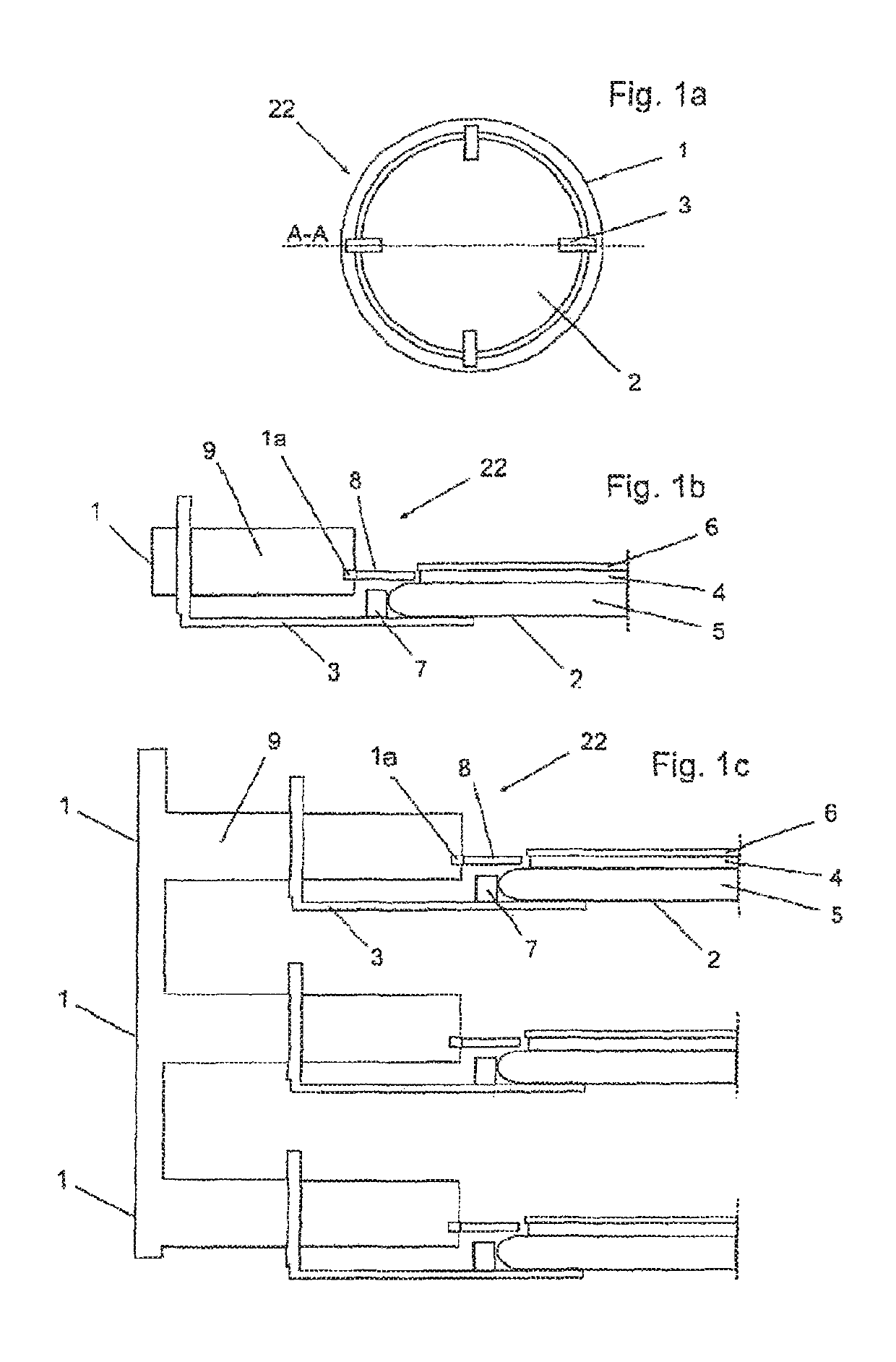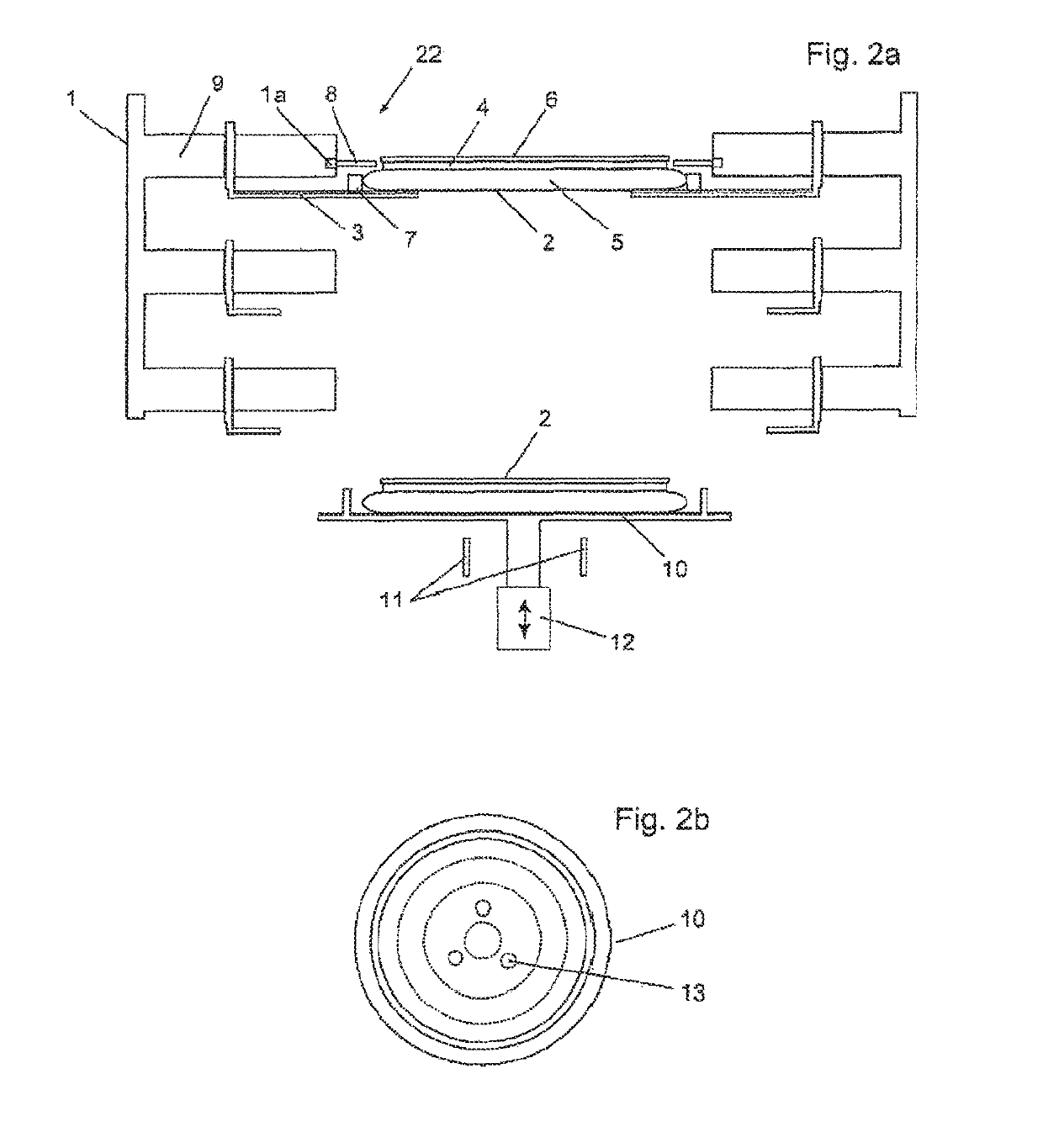Device and method for at least partly dissolving a connecting layer of a temporarily bonded substrate stack
- Summary
- Abstract
- Description
- Claims
- Application Information
AI Technical Summary
Benefits of technology
Problems solved by technology
Method used
Image
Examples
first embodiment
[0058]FIG. 1a diagrammatically shows a top view of a device 22 according to the invention in accordance with a first embodiment with a line of intersection A-A. FIG. 1b shows a diagrammatic half of a cross-sectional view of the device 22 along the line of intersection A-A. The other half is designed in mirror image.
[0059]As shown in the embodiment according to FIGS. 1a and 1b, the device 22 has a ring 1. The ring 1 is equipped with pivoting holding devices 3 with attaching pins 7 in order to hold a substrate stack 2 in a partial-dissolving position. The attaching pins 7 are advantageously cylindrical or have slightly conical tips, but they can also have other suitable shapes and / or sizes. The substrate stack 2 is comprised of a carrier substrate 5 and a product substrate 6, which are temporarily bonded with one another via a connecting layer e.g., an adhesive layer.
[0060]The ring 1 is mounted preferably 0.1 to 15 mm, more preferably 0.1 to 10 mm, most preferably 0.1 to 8 mm, and wit...
second embodiment
[0066]FIG. 1c shows one half of a diagrammatic cross-sectional view of a device 22 according to the invention in accordance with a The other half is designed in mirror image. In FIG. 1c, three rings 1 that are in particular designed identically as well as corresponding holding devices 3 are arranged vertically stacked one above the other. All rings 1 are installed in a closed chamber (not shown). The stacked rings 1 are connected to one another and are supplied by means of connecting lines or supply lines 9 with solvent by means of a high-power circulating pump.
[0067]Multiple rings 1 can be arranged one above the other in any number, preferably 2 to 30, more preferably 2 to 15, most preferably 2 to 10, and with utmost preference 2 to 5 rings 1, so that multiple substrate stacks 2 can be treated at the same time.
third embodiment
[0068]FIG. 2a diagrammatically shows a cross-sectional view of a device 22 according to the invention in accordance with a The device 22 can be designed as described in FIG. 1c, whereby the device 22 in addition has a receiving system 10. The upper ring 1 is already loaded with a substrate stack 2 in this depiction. A second substrate stack is located on the receiving system 10.
[0069]The substrate stack 2 may have been previously loaded by a robot (not shown) onto the receiving system (in particular a chuck) 10. The receiving system 10 is designed in such a way that the robot can remove the substrate stack 2 again after the loosening or partial dissolving. The substrate stack 2 is advantageously attached to the receiving system 10 that can move parallel to the z-direction (vertical direction). The receiving system 10 moves, in particular is driven over a shaft 12, upward in the z-direction and brings the substrate stack 2 into the vicinity of the middle holding device 3. After that...
PUM
 Login to View More
Login to View More Abstract
Description
Claims
Application Information
 Login to View More
Login to View More - R&D
- Intellectual Property
- Life Sciences
- Materials
- Tech Scout
- Unparalleled Data Quality
- Higher Quality Content
- 60% Fewer Hallucinations
Browse by: Latest US Patents, China's latest patents, Technical Efficacy Thesaurus, Application Domain, Technology Topic, Popular Technical Reports.
© 2025 PatSnap. All rights reserved.Legal|Privacy policy|Modern Slavery Act Transparency Statement|Sitemap|About US| Contact US: help@patsnap.com



